brinla
Extreme values using INLA
Julian Faraway 21 February 2022
See the introduction for more about INLA. Load in the packages:
library(INLA)
library(brinla)
Data
Extreme flows in rivers are of special interest since flood defences must be designed with these in mind. The National River Flow Archive provides data about river flows in the United Kingdom. For this example, we consider data on annual maximum flow rates from the River Calder in Cumbria, England from 1973 to 2014:
data(calder, package = "brinla")
plot(Flow ~ WaterYear, calder)
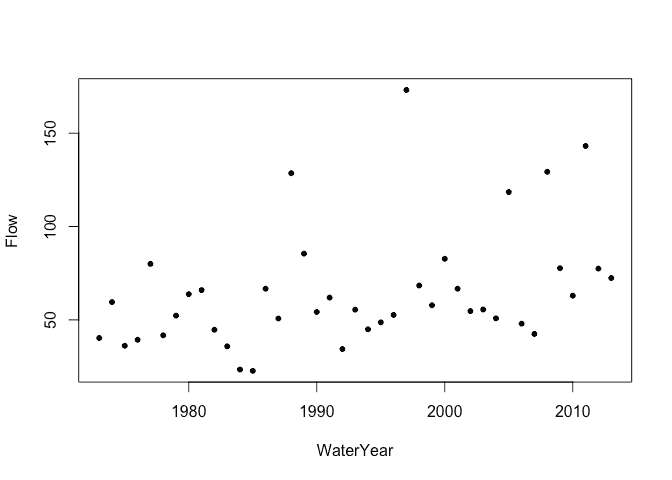
Rescale year for convenience:
calder$year = calder$WaterYear-1973
Generalized Extreme value distribution
Some scaling is necessary to get the model to fit. Generalized extreme
value distributions are notoriously difficult to fit. It is not unusual
to see failures to fit which require some tinkering to rectify. The
current implementation is marked as experimental so you may experience
some difficulties with the fit. We will need the
control.compute = list(config=TRUE) in the computations later in this
example.
imod <- inla(Flow ~ 1 + year, data = calder, family = "gev", scale = 0.1, control.compute = list(config=TRUE))
imod$summary.fixed
mean sd 0.025quant 0.5quant 0.975quant mode kld
(Intercept) 36.60812 5.85907 25.18367 36.54763 48.3342 36.40377 5.7647e-05
year 0.76643 0.25438 0.27329 0.76397 1.2793 0.76394 2.1949e-05
We can see that there is positive linear trend term indicating the peak flows for this river are increasing over time. We can plot the fixed effect posterior for the year:
plot(imod$marginals.fixed$year, type="l")
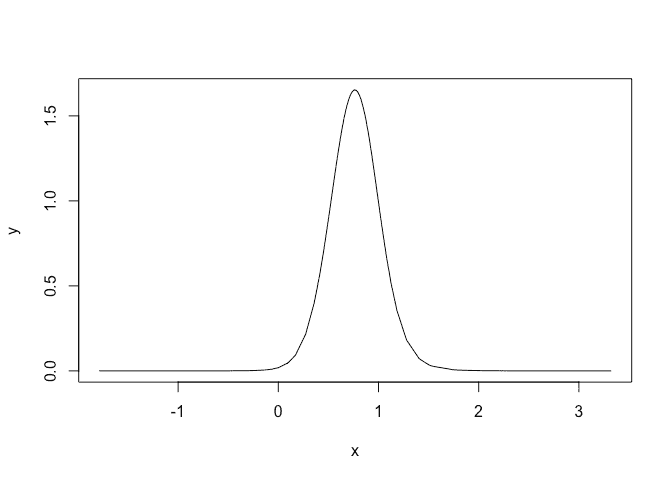
We can see that the posterior for the trend in year is concentrated above zero indicating evidence of an increasing trend. Probability that slope is negative is:
inla.pmarginal(0, imod$marginals.fixed$year)
[1] 0.0019367
Rather small.
Plot the posterior for the precision:
plot(imod$marginals.hyperpar$`precision for GEV observations`,type="l",xlim=c(0,0.1))
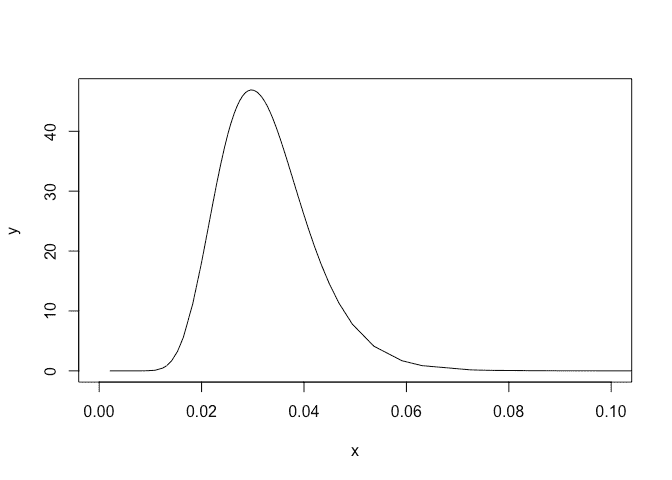
or plot that on an SD scale:
plot(bri.hyper.sd(imod$marginals.hyperpar$`precision for GEV observations`),type="l")
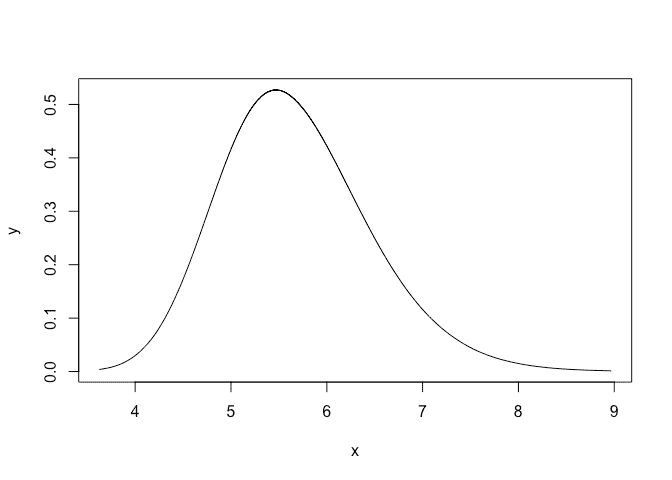
Plot the posterior for the tail parameter:
plot(imod$marginals.hyperpar$`tail parameter for GEV observations`,type="l",xlim=c(-0.2,0.5))

A small chance that this is negative.
Predictions
The maximum flow over the period observation occured in the 1997 water
year measuring 173.17 m^3/s. Under our fitted model, what was the
probability of observing such a flow (or greater)? This will give us a
measure of how unusual this event was. First we need an R function to
compute P(Y < y) for the generalized extreme value distribution:
pgev = function(y,xi,tau,eta,sigma=1){
exp(-(1+xi*sqrt(tau*sigma)*(y-eta))^(-1/xi))
}
Compute probability of observed flow less than this maximum flow in 1997:
yr = 1997-1973
maxflow = 173.17
eta = sum(c(1,yr)*imod$summary.fixed$mean)
tau = imod$summary.hyperpar$mean[1]
xi = imod$summary.hyperpar$mean[2]
sigma = 0.1
(pless = pgev(maxflow, xi, tau, eta,sigma))
[1] 0.99113
So probability of exceeding the observed value is:
1-pless
[1] 0.0088729
Hydrologists often work with the expected time for the event to occur called the recurrence interval. In this case, the value is:
1/(1-pless)
[1] 112.7
Now set year to 2017:
yr = 2017-1973
maxflow = 173.17
eta = sum(c(1,yr)*imod$summary.fixed$mean)
tau = imod$summary.hyperpar$mean[1]
xi = imod$summary.hyperpar$mean[2]
sigma = 0.1
pless = pgev(maxflow, xi, tau, eta,sigma)
1/(1-pless)
[1] 71.433
We see that the recurrence interval substantially reduced.
Credibility interval
Can compute a 95% credibility interval. Need to sample from the full
posterior. This is where we need the
control.compute = list(config=TRUE) option.
nsamp = 999
postsamp = inla.posterior.sample(nsamp, imod)
pps = t(sapply(postsamp, function(x) c(x$hyperpar, x$latent[42:43])))
colnames(pps) <- c("precision","shape","beta0","beta1")
Plot the sampled hyperparameters:
plot(pps[,1],pps[,2]*0.01,xlab="Precision",ylab="Shape")
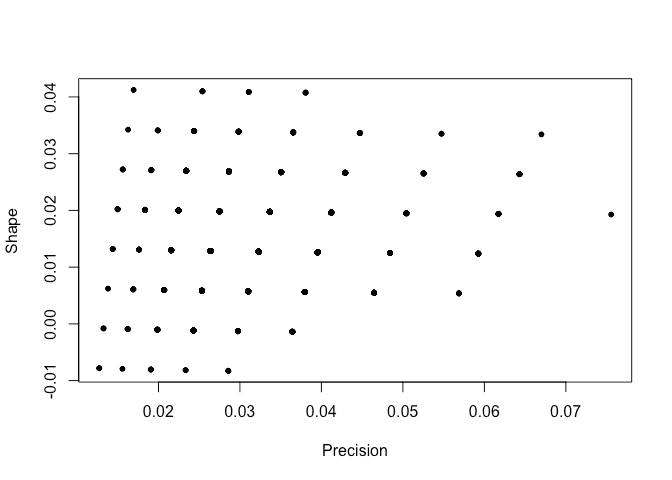
We see that the sampled hyperparameters are concentrated on a sparse grid. Here is the sampled posterior for the linear model parameters:
plot(pps[,3],pps[,4])
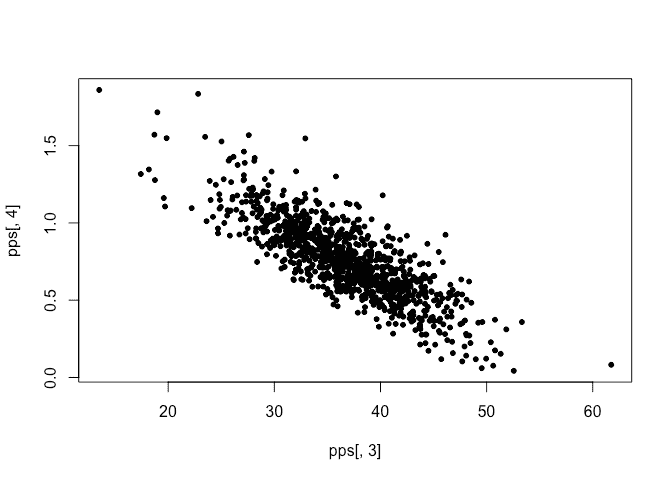
No problem with this. We compute the recurrency interval for each sample.
sigma = 0.1
maxflow = 173
retp = numeric(nsamp)
for(i in 1:nsamp){
eta = sum(c(1,yr)*pps[i,3:4])
tau = pps[i,1]
xi = 0.01*pps[i,2]
pless = pgev(maxflow, xi, tau, eta,sigma)
retp[i] = 1/(1-pless)
}
From this we can compute the credibility interval:
quantile(retp, c(0.025, 0.5, 0.975))
2.5% 50% 97.5%
48.393 248.126 2074.246
This is quite wide. If we want a denser grid for the hyperparameters, we can redo INLA with a smaller step size for the grid. We will get denser coverage but it’s still a grid. This is somewhat undesirable but not as bad as it seems because these are the integration points.
Package versions
sessionInfo()
R version 4.1.0 (2021-05-18)
Platform: x86_64-apple-darwin17.0 (64-bit)
Running under: macOS Big Sur 10.16
Matrix products: default
BLAS: /Library/Frameworks/R.framework/Versions/4.1/Resources/lib/libRblas.dylib
LAPACK: /Library/Frameworks/R.framework/Versions/4.1/Resources/lib/libRlapack.dylib
locale:
[1] en_GB.UTF-8/en_GB.UTF-8/en_GB.UTF-8/C/en_GB.UTF-8/en_GB.UTF-8
attached base packages:
[1] parallel stats graphics grDevices utils datasets methods base
other attached packages:
[1] brinla_0.1.0 INLA_22.01.25 sp_1.4-6 foreach_1.5.2 Matrix_1.4-0 knitr_1.37
loaded via a namespace (and not attached):
[1] rstudioapi_0.13 magrittr_2.0.2 splines_4.1.0 mnormt_2.0.2 lattice_0.20-45
[6] Deriv_4.1.3 rlang_1.0.1 fastmap_1.1.0 stringr_1.4.0 highr_0.9
[11] tools_4.1.0 grid_4.1.0 tmvnsim_1.0-2 xfun_0.29 cli_3.1.1
[16] htmltools_0.5.2 iterators_1.0.14 MatrixModels_0.5-0 yaml_2.2.2 digest_0.6.29
[21] numDeriv_2016.8-1.1 codetools_0.2-18 evaluate_0.14 sn_2.0.1 rmarkdown_2.11
[26] stringi_1.7.6 compiler_4.1.0 stats4_4.1.0